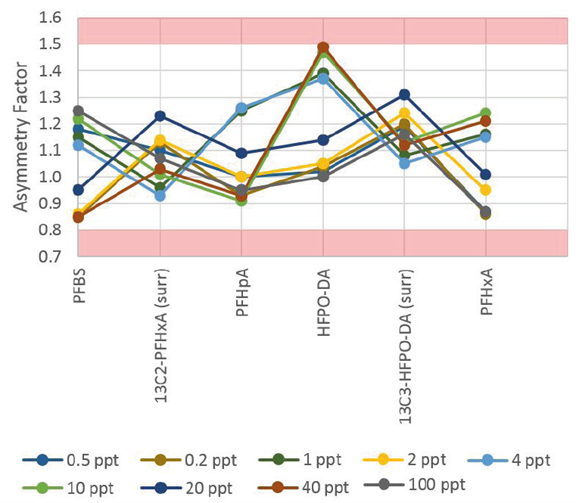In the United States, the Environmental Protection Agency (EPA) establishes performance criteria in which laboratories must demonstrate their technical capability to produce results that are accurate and consistent with industry standards. In this blog, I will explain what peak asymmetry is and why laboratories utilize it for EPA method 537.1.
What is peak asymmetry factor?
EPA Method 537.1 utilizes Liquid Chromatography/Tandem Mass Spectrometry (LC/MS/MS) to quantify the concentration of 18 different Per- and polyfluoroalkyl substances (PFAS) that have potential to be found in drinking water samples. To confirm the analytical conditions are acceptable, it is important to look at the shape of the peaks for individual PFAS analytes that have been chromatographically separated by the LC/MS/MS system. Peak shape evaluates the symmetry of the front and back slope by drawing a line from the top of the peak to the point where it intersects at the base. Good shape would be a peak that is perfectly symmetrical on both sides making a perfect “bell curve”. As the peak shape becomes more skewed the more asymmetric the peak becomes which for LC/MS/MS is an indication of poor chromatographic separation which can negatively impact quantification of the target PFAS analytes.
What is EPA 537.1 peak asymmetry criteria?
EPA method 537.1 uses the asymmetry factor to measure chromatographic performance. Although there are 18 target analytes EPA 537.1 only requires that the first two eluting peaks on a single mid-level calibration standard have their peak asymmetry factors calculated. The method also states that the results of this calculation must fall within a range of 0.8-1.5. In the figure below, we investigated peak asymmetry for a broadened list of six early eluting PFAS compounds and at multiple calibration levels. The data demonstrates that with good analytical technique it is possible to meet EPA 537.1 asymmetry factor requirements for the first six eluting compounds across all calibration levels. It is also interesting to note that the data demonstrates that the asymmetry factor for individual PFAS compounds may change at different concentrations. This information shows that the concentration of PFAS analytes in your samples can impact the LC/MS/MS performance and could provide a useful test for laboratories looking at analytical performance over a wide concentration range.

Do all PFAS testing methods have peak asymmetry criteria?
Laboratories familiar with EPA 537.1 may be familiar with method 533 which is also utilized for the quantification of PFAS analytes in drinking water samples. One of the biggest differences between these methods is that EPA 533 uses an isotope dilution technique for measuring target analyte concentrations. Using the ratio of the LC/MS/MS peak area from the target PFAS analyte to that of a known amount of an isotopically labeled PFAS analogue (isotopologue) allows the laboratory to correct for analyte specific peak asymmetry. The reason behind this is that isotopologues closely match the method analyte the same functional groups and differ only in the number of neutrons in one of the atoms within the molecule. This allows the analyst to correct for peak asymmetry by normalizing variation in the peak shape to that of the isotope dilution standard. Therefore, peak asymmetry criteria are not listed in EPA method 533.
Summary
Per- and polyfluoroalkyl substances (PFAS) have been linked to (medical issues) and therefore are one of the most concerning types of organic pollutants we are finding in our environment. To assess the proliferation of these hazardous compounds in our drinking water supply, the EPA has developed methods 537.1 & 533 for quantification using LC/MS/MS. It is important for laboratories to understand the underlying fundamentals of the method criteria such as peak asymmetry factor to produce accurate results. Taking steps to ensure laboratories produce high quality data allows environmental compliance regulators to better decisions about our environment and preserve the planet for future generations of humankind.
Follow the link below to learn more about EPA 537.1 acceptance criteria!

 Organic Workflow
Organic Workflow Peptide Workflow
Peptide Workflow Scale-Up Flash Purification
Scale-Up Flash Purification  Sample Preparation
Sample Preparation Biomolecule Purification
Biomolecule Purification Oligo synthesis
Oligo synthesis Scavengers and Reagents
Scavengers and Reagents Service & Support
Service & Support Accessories & Spare parts
Accessories & Spare parts Investors
Investors Reports & News
Reports & News The Share
The Share Corporate Governance
Corporate Governance Calendar
Calendar Sustainability
Sustainability Our Offering
Our Offering Our History
Our History Our Locations
Our Locations Leadership
Leadership